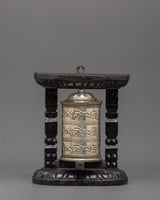
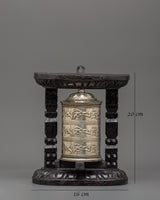
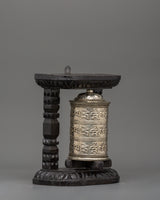
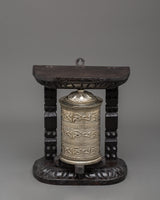
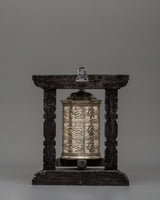
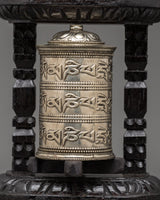
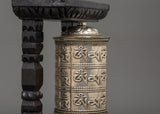
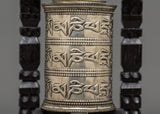
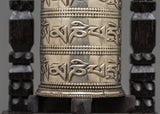
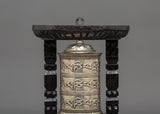
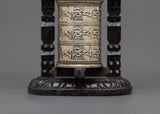
Brass & Copper Mantra Wheel | Tibetan Prayer Wheel for Spiritual Practice
Brass & Copper Mantra Wheel - Om Mani Padme Hum
--------------------------------------------------------
Size: 20cm(Height) x 16cm(Width)
Weight: 0.40kg
Materials: Copper Body, Brass Body, Wood
--------------------------------------------------------
About our Prayer Wheel
This exquisitely crafted Brass and copper Mantra Wheel can help you embrace the divine rhythm of awareness. A dark wood frame and a stunning copper and brass body surround it. Om Mani Padme Hum is engraved on the prayer wheel's body, a potent mantra thought to create compassion, cleanse karma, and generate spiritual merit with each rotation. This 20-cm-tall spiritual object is a valuable addition to regular prayer and meditation routines and an attractive altar piece.
The wheel, skillfully produced by talented artisans, offers a tactile and symbolic experience founded in Tibetan Buddhist traditions. It revolves smoothly within its carved wooden base. The inscriptions exude religious energy, and the combination of copper and brass guarantees durability and aesthetic appeal. It is sturdy and lightweight (0.40kg) and looks great on meditation nooks, personal shrines, or as a spiritual present. With each thoughtful spinning, welcome blessings into your area and embrace your exercise with intention.
Introduction to Prayer Wheel
A prayer wheel is cylindrical on a spindle and is used in Tibetan Buddhism. It is typically inscribed with the mantra "Om Mani Padme Hum" and rotated by hand as a form of spiritual practice and to accumulate merit. Spinning the wheel is believed to have the same spiritual benefits as verbally reciting the mantra. The use of prayer wheels is widespread in Tibetan Buddhism and has spread to other cultures.
How does the Buddhist Prayer Wheel benefit us?
The benefits associated with rotating the wheel are numerous. It promotes knowledge, compassion, and bodhicitta in the practitioner and improves siddhis (spiritual powers such as clairvoyance, precognition, etc.). The practitioner can repeat the mantra as often as possible while the wheel is rolling, maintaining a calm, meditative attitude. A Tibetan Buddhist tradition holds that after a practice session, one should dedicate any acquired merits to the benefit of all sentient beings. Then three times Om Ah Hum. This is usually among Tibetans after finishing any Buddhist practice, including the prayer wheel exercise.
How do you set up your own Buddhist Shrine?
• Find a clean, quiet, and uncluttered spot
• Set up an altar table and cover it with an altar cloth that calls to you
• Place your sacred item at the center

















